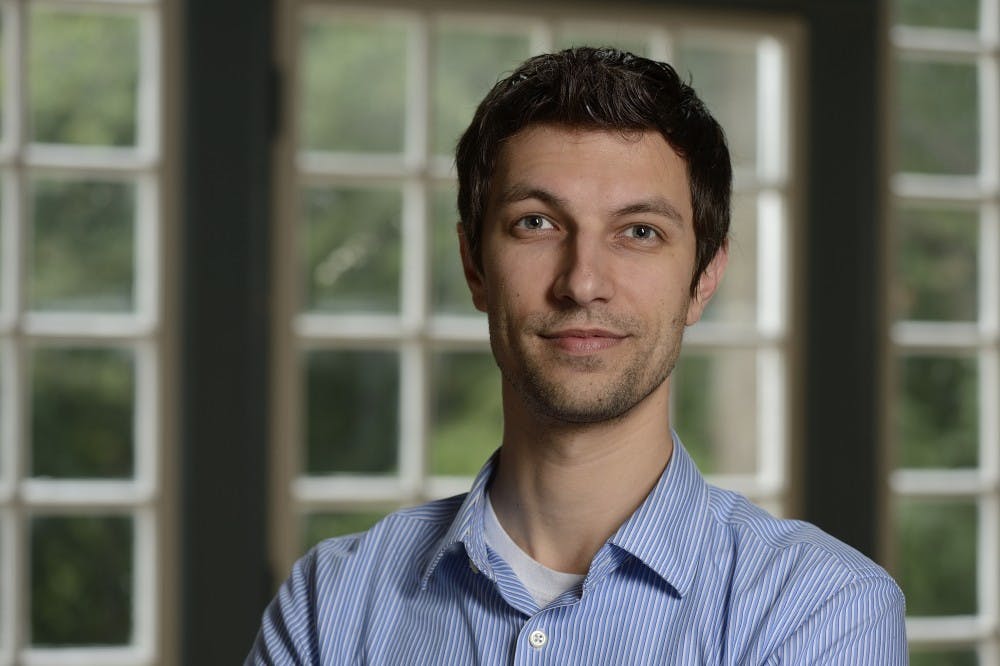Kevin Lewis’ most recent project was to use gravity to “weigh a mountain” on Mars.
In introductory physics classes, gravity is taught to be a constant equal to 9.8 meters per second. In reality, it varies from place to place depending on what is beneath you. If you stand on an iron ore, the pull of gravity will be a bit stronger. This quality makes gravity a useful geological tool to interrogate the subsurface of a planet. If gravity measurements do not match previously established expectations, then scientists can discern the density of the rocks underneath the surface.
Lewis, who is an assistant professor in the department of Earth and Planetary Sciences (EPS), calibrated an instrument on the Mars Curiosity rover which measures the density of a mountain on Mars, in effect, “weighing” it.
So far, the rocks have been low density which suggests that they have not been buried very deeply. Otherwise, they would have been compacted by the weight of overlaying rocks.
Lewis has been researching Mars since his undergraduate years. In his first project he made synthetic ice samples to test an instrument designed to investigate the layering of polar ice caps on Mars. Now, Lewis and some of his lab members are part of the 300 person team who are working with the Mars Curiosity rover. Lewis joined the team in 2012 just before the rover landed. In his monthly shifts at the National Aeronautics and Space Association’s (NASA) Goddard Space Flight Center he is responsible for driving the rover and collecting the data and observations that other scientists request, but students in Lewis’ group can remain in the lab and still see Mars and walk around like they are on it.
In the lab there is a virtual reality helmet that lets the user see everything the Curiosity sees or has seen. The software for the helmet was developed in the NASA Jet Propulsion Laboratory.
One of Lewis’ graduate students uses the virtual reality helmet to track the movement of sand. The movement indicates the direction of wind and therefore how active the modern surface is.
According to Lewis, the movement of sand is surprising because the atmosphere is very thin, about 1 percent of the Earth’s atmosphere. The data may have implications for future human explorers.
Another graduate student is studying the rock layers on Mars to see if conditions existed to evolve life. If it did, that would suggest that life is common in the universe, or at the very least, not unique.
The virtual reality helmet is not just for seeing things as Curiosity does. It is also equipped with a Chemistry and Camera complex, informally called ‘ChemCam’, which contains a rock laser. The laser can zap rocks a couple meters away and gauge its chemistry. The Lewis lab has an analog to that instrument to run comparison experiments. A group of lab members are going to The Palisades in the summer to conduct experiments on the cliffside.
Currently, the Curiosity rover is exploring Gale Crater. It is a 100 km crater with a 5 km tall mountain in the middle. The mountain appears to be sedimentary which means that it contains a record of climate, lakes, rivers, glaciers and all the processes that erode and transport things on the surface of the planet. Lewis calls the mountain a “history book”.
Thus, the scope of the lab ranges from studying small grains of sand to understanding the modern heath flow of a planet. Broadly, the lab seeks to understand the history of Mars and other terrestrial planets – Mercury, Venus and Earth. Lewis describes his research as a combination between geophysics and geology.
In Lewis’ experience, being a planetary scientist at Hopkins has many advantages, the foremost of which is the breath of resources available to students. The large numbers of leading research institutions in the locale surrounding Hopkins creates a rich research environment for students. Carnegie Institution for Science, the Smithsonian and NASA headquarters are only a short MARC train ride away. The Applied Physics Lab at Hopkins is also involved in work in the earth and planetary sciences.
Students interested in joining the Lewis Lab or other labs in the EPS department do not have to be geology majors. Students with a background in engineering, physics, quantitative or programming abilities or simply an interest in the field can find a project.
Those who want to satiate their interest in geology and the planetary sciences can enroll in classes like Dynamic Earth: An Introduction to Geology or Guided Tour: The Planets. Lewis offers a field trip class one weekend in a semester for students who want to study local geology. Last fall, the class went to The Palisades and Sterling Hill Mine.
As Lewis said, “anything with a surface is potentially interesting.”





